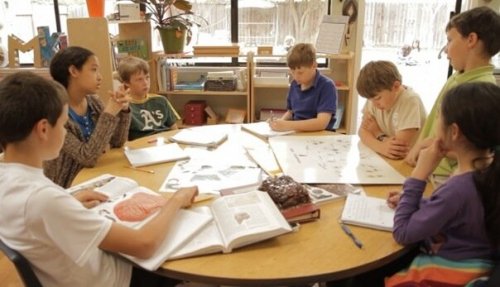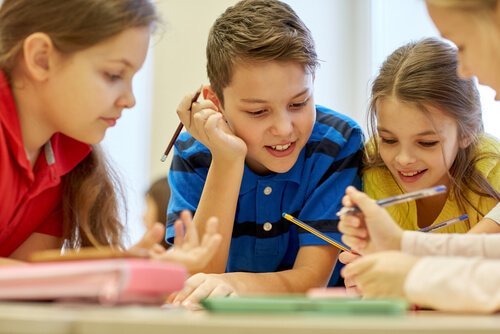Spencer Kagan and Cooperative Learning

Spencer Kagan is a renowned author who has carried out multiple studies on cooperative learning. This type of teamwork is different from the way professors transmit knowledge in the vast majority of schools and institutes today. In fact, it’s a new method of group learning that helps the students develop significant personal growth skills.
After doing extensive research, Kagan made a proposal regarding what was commonly known as cooperative learning. He organized the cooperative method in a much more flexible and effective way. It allows people to learn about complex and generic subjects through dynamic processes. Kagan published an article in Kagan Online Magazine where he explained that this method was like a game which allowed individuals to learn while being entertained. Let’s expand on this.
The principles of cooperative learning
When Spencer Kagan designed the structures of his proposal for cooperative learning, he thought of four basic principles that we should always keep in mind if we want to put it into practice. As a matter of fact, they’re fundamental elements of this type of learning.
- Positive interdependence: This is achieved by fulfilling the responsibility of carrying out the assigned task individually. Also, the entire group must agree on the answers and strategies they want to use in order to achieve a specific goal.
- Individual responsibility: The actions of every member of the group will directly impact the group as a whole. Of course, this impact can be positive or negative. Each member is responsible for carrying out their task for the sake of the rest of the group.
- Equal participation: All group members should have an equal opportunity to participate in the activity. A very important part of this principle is that the work should be distributed equally to begin with. One member shouldn’t have more work than another.
- Simultaneous interaction: All participants must communicate with one another. That is, share their opinions, voice their emotions regarding the work, and make joint decisions. If there’s a lack of interaction, the group may break up, which could hinder the achievement of their goal.

That being said, cooperative learning allows students to:
- Develop teamwork skills.
- Improve problem resolution.
- Improve their ability to defend a particular point of view.
- Learn to listen to others and respect their ideas, as well as express their own.
The advantages of cooperative learning
Cooperative learning allows the implementation of a series of games (structures) that work with specific principles and clear goals in the classrooms. Every single one of them can be applied to different classes such as mathematics or language. This means that cooperative learning can work even in the subjects where you least expect it to.
A very important fact about cooperative learning is that it can be used to teach different kinds of students. We can tell that most schools and institutes use a traditional education system aimed at only one type of student. Now, what about those who are more creative? Or those who have a difficult time memorizing specific kinds of information? In those cases, Spencer Kagan’s structures are useful since they allow for more complete learning.

The need for the implementation of cooperative learning
Some teachers may think that teaching a class based on cooperative learning can be annoying. However, in reality, it involves much less preparation and the results are more effective. Although many learning institutions have a determined teaching method, we believe it’s important to introduce some of Kagan’s structures and encourage them to try them out. That way, they’ll be able to see first-hand if it yields good results or not.
As we’ve said before, “traditional” education is the most common type used in schools despite its ineffectiveness. Traditional education doesn’t encourage the students to learn, it bores them. It makes the students ask themselves in the middle of class “Why are we studying this? What’s the point?” Additionally, it promotes unhealthy competition among students.
One thing is certain: being the best out of the whole class by memorizing everything just to get the teacher’s attention hinders the development of the skills Kagan talks about. In brief, educators should keep in mind that students should be able to work, progress, learn, and function as productively as they can and, for that, they should put the strategies that best suit them into practice.
Spencer Kagan is a renowned author who has carried out multiple studies on cooperative learning. This type of teamwork is different from the way professors transmit knowledge in the vast majority of schools and institutes today. In fact, it’s a new method of group learning that helps the students develop significant personal growth skills.
After doing extensive research, Kagan made a proposal regarding what was commonly known as cooperative learning. He organized the cooperative method in a much more flexible and effective way. It allows people to learn about complex and generic subjects through dynamic processes. Kagan published an article in Kagan Online Magazine where he explained that this method was like a game which allowed individuals to learn while being entertained. Let’s expand on this.
The principles of cooperative learning
When Spencer Kagan designed the structures of his proposal for cooperative learning, he thought of four basic principles that we should always keep in mind if we want to put it into practice. As a matter of fact, they’re fundamental elements of this type of learning.
- Positive interdependence: This is achieved by fulfilling the responsibility of carrying out the assigned task individually. Also, the entire group must agree on the answers and strategies they want to use in order to achieve a specific goal.
- Individual responsibility: The actions of every member of the group will directly impact the group as a whole. Of course, this impact can be positive or negative. Each member is responsible for carrying out their task for the sake of the rest of the group.
- Equal participation: All group members should have an equal opportunity to participate in the activity. A very important part of this principle is that the work should be distributed equally to begin with. One member shouldn’t have more work than another.
- Simultaneous interaction: All participants must communicate with one another. That is, share their opinions, voice their emotions regarding the work, and make joint decisions. If there’s a lack of interaction, the group may break up, which could hinder the achievement of their goal.

That being said, cooperative learning allows students to:
- Develop teamwork skills.
- Improve problem resolution.
- Improve their ability to defend a particular point of view.
- Learn to listen to others and respect their ideas, as well as express their own.
The advantages of cooperative learning
Cooperative learning allows the implementation of a series of games (structures) that work with specific principles and clear goals in the classrooms. Every single one of them can be applied to different classes such as mathematics or language. This means that cooperative learning can work even in the subjects where you least expect it to.
A very important fact about cooperative learning is that it can be used to teach different kinds of students. We can tell that most schools and institutes use a traditional education system aimed at only one type of student. Now, what about those who are more creative? Or those who have a difficult time memorizing specific kinds of information? In those cases, Spencer Kagan’s structures are useful since they allow for more complete learning.

The need for the implementation of cooperative learning
Some teachers may think that teaching a class based on cooperative learning can be annoying. However, in reality, it involves much less preparation and the results are more effective. Although many learning institutions have a determined teaching method, we believe it’s important to introduce some of Kagan’s structures and encourage them to try them out. That way, they’ll be able to see first-hand if it yields good results or not.
As we’ve said before, “traditional” education is the most common type used in schools despite its ineffectiveness. Traditional education doesn’t encourage the students to learn, it bores them. It makes the students ask themselves in the middle of class “Why are we studying this? What’s the point?” Additionally, it promotes unhealthy competition among students.
One thing is certain: being the best out of the whole class by memorizing everything just to get the teacher’s attention hinders the development of the skills Kagan talks about. In brief, educators should keep in mind that students should be able to work, progress, learn, and function as productively as they can and, for that, they should put the strategies that best suit them into practice.
All cited sources were thoroughly reviewed by our team to ensure their quality, reliability, currency, and validity. The bibliography of this article was considered reliable and of academic or scientific accuracy.
- Bouzas, P. G. (2002). Repercusión del aprendizaje cooperativo sobre el rendimiento y desarrollo personal y social de los estudiantes. Revista de ciencias de la educación: Organo del Instituto Calasanz de Ciencias de la Educación, (192), 505-522.
- Kagan, S. (2003). Breve historia de las Estructuras Kagan. Kagan Online Magazine, 1(800), 3-20.
- Prenda, N. P. (2011). El aprendizaje cooperativo y sus ventajas en la educación intercultural. Hekademos: Revista educativa digital, (8), 63-76.
This text is provided for informational purposes only and does not replace consultation with a professional. If in doubt, consult your specialist.







